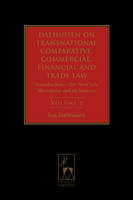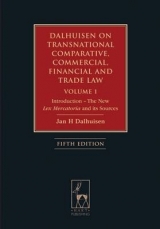
Dalhuisen's Transnational Comparative, Commercial, Financial and Trade Law
Hart Publishing (Verlag)
978-1-84946-059-0 (ISBN)
- Titel erscheint in neuer Auflage
- Artikel merken
VOLUME 1This is the fourth edition of the leading work on transnational and comparative commercial and financial law, covering a wide range of complex topics in the modern law of international commerce, finance and trade. As a guide for students and practitioners it has proven to be unrivalled. In a significant departure from earlier editions, the work is now divided into three volumes, each of which can be used independently or as part of the complete work. Volume one covers the introductory material - the historical roots and foundations of private law, the concept and forces of its transnationalisation in the professional sphere, the autonomous sources of the new law merchant or modern lex mercatoria and its largely finance-driven impulses. All three volumes may be purchased separately or as a single three volume boxed set. From the reviews of previous editions:"...synthesizes and integrates diverse bodies of law into a coherent and accessible account...remarkable in its scope and depth. It stands alone in its field not only due to its comprehensive coverage, but also its original methodology.
Although it appears to be a weighty tome, in fact, in light of its scope, it is very concise. While providing a wealth of intensely practical information, its heart is highly conceptual and very ambitious...likely to become a classic text in its field."American Journal of Comparative Law"Dalhuisen's style is relaxed...what he writes convinces without the need for an excess of references to sources...a highly valuable contribution to the legal literature. It adopts a useful, modern approach to teaching the young generation of lawyers how to deal with the increasing internationalisation of law. It is also helpful to the practising lawyer and to legislators."Uniform Law Review/Revue de Droit Uniforme"this is a big book, with big themes and an author with the necessary experience to back them up...Full of insights as to the theories that underlie the rules governing contract, property and security, it is an important contribution to the law of international commerce and finance."Law Quarterly Review"...presents a very different case: that of a civilized and cultivated cosmopolitan legal scholar, with a keen sense of international commercial and financial practice, with an in-depth grounding in both comparative legal history and comparative law, combined with the ability to transcend conventional English black-letter law description with critical judgment towards institutional wisdom and intellectual fashions.
..a wide-ranging, historically and comparatively very deep and comprehensive commentary, but which is also very contemporary and forward-looking on many or most of the issues relevant in modern transnational commercial, contract and financial transactions..."International and Comparative Law Quarterly
Jan Dalhuisen is Professor of Law at King's College London, and a regular Visiting Professor at the University of California at Berkeley, the Tsinghua University in Beijing, and the University of New South Wales in Sydney Australia.
Part I The Transnationalisation of Commercial and Financial Law. The Law Concerning Professional Dealings 1.1 Introduction 1.1.1 The Place and Evolution of Modern Commercial and Financial Law in Civil and Common Law. The Concept of Transnationalisation 1.1.2. The Transnationalisation of Commercial and Financial Law. Common or Civil Law Approach? Methodology1.1.3 The Coverage of Domestic and Transnational Commercial and Financial Law1.1.4 Legal Dynamism as Key Notion in Transnational Commercial and Financial Law. Law as a DynamicConcept in Modern Contract and Movable Property 1.1.5. Legal Pragmatism at the Transnational Level. Notions of Certainty, Finality and Predictability. The Need to Find Structure, Not System 1.1.6 Social, Economic, Intellectual or Democratic Legitimacy 1.1.7 The Traditional Civil and Common Law Notions of Commercial Law. The Notion of Commerciality 1.1.8 Old and New Commercial and Financial Law. Transnational Notion of Professionality, a SeparateLegal Order for Professional Dealings, and the Role of International Arbitrators 1.1.9 International Commercial Arbitration and International Commercial Courts 1.1.10 Structure of this Volume 1.2 The Origin and Evolution of Civil Law. Its Traditional Approach to Law Formation and to the Operation of Private Law (including Commercial and Financial Law) 1.2.1 The Evolution of Modern Private Law and its Sources 1.2.2 The Early Developments on the European Continent. Roman Law 1.2.3 Classical Roman Law and the Corpus Iuris Civilis 1.2.4 The Revival of Roman Law in Western Europe: The Ius Commune 1.2.5 The Ius Commune and its Relationship to Local Law, Including Newer Commercial Law 1.2.6 The Early Evolution of the Notion of Natural Law in Europe 1.2.7 The Emergence of the Secular Natural Law School: Grotius's De Iure Belli ac Pacis, its Approach andImpact 1.2.8 The Status of State Law in the Philosophies of Grotius, Hobbes, Locke, Kant and Hegel. The Impact of the Age of Enlightenment and the Road to Codification of Private Law in France 1.2.9 The German Historical and Romantic Schools. The Road to Private Law Codification in Germany 1.2.10 The Civil Law National Codifications and their Coverage 1.2.11 Nationalism and System Thinking. The Question of the Continued Relevance of the Civil La Codification Idea 1.2.12 Modern Policy Arguments in Favour of a Statist and Static Attitude towards the Formation of Private Law. Deficiency in System Thinking. Misunderstandings concerning Democratic Legitimacy and Certainty 1.2.13 System Thinking and Interpretation in Civil Law: Begriffs- and Interessenjurisprudenz. ModernHermeneutics 1.3 The Origin and Evolution of the Common Law. Its Approach to Law Formation and the Operation of Private Law 1.3.1 Common Law and Equity 1.3.2 The Common Law Approach to Scholarship 1.3.3 The Common Law Approach to Precedent, Legislation or Codification, and Statutory Interpretation 1.3.4 Intellectualisation and Conceptualisation in Common Law. Modern American Academic Attitudes towards the Law and its Development: Legal Formalism and Realism 1.3.5 Post-realism or Legal Functionalismin the US: The 'Law and ' Movements 1.3.6 The Progress So Far 1.4 The Sources of Law in Civil and Common Law Tradition. The Approach in Transnational Private Law and the Hierarchy of Sources and Norms in the Modern Lex Mercatoria 1.4.1 Statutory and Other Sources of Law. Nationalism and System Thinking in Civil and Common Law 1.4.2 Fact- and Law-finding in Civil and Common Law 1.4.3 The Revival of the Traditional Sources of Law through Liberal Interpretation Techniques 1.4.4 Survival of Transnational Legal Sources in Commercial Law. EU and Public International Law Attitudes 1.4.5 Autonomous Legal Sources: Fundamental Principle 1.4.6 Autonomous Legal Sources: General Principle 1.4.7 Autonomous Legal Sources: Custom and Practices 1.4.8 The Competition Between Custom and Statutory or Treaty Law 1.4.9 Autonomous Legal Sources: Party Autonomy 1.4.10 Autonomous Legal Sources: Treaty Law 1.4.11 Uniform Law and Private International Law 1.4.12 Domestic Laws as Autonomous Source of Transnational Law 1.4.13 The Hierarchy of the Sources of Law in Modern International Commercial and Financial Law 1.4.14 The Concept of Natural Law and the Legal Status and Force of Fundamental and General Principle in the Modern Lex Mercatoria 1.4.15 An End to the Confining Views of Modern Legal Positivism, Formalism, and Nationalism in theProfessional Sphere 1.4.16 Dispute Prevention or Dispute Resolution? Law in Action or Law in Litigation 1.4.17 The Role of National Courts and of International Commercial Arbitration 1.4.18 Agents of International Convergence and Harmonisation: The Role of UNIDROIT, UNCITRAL, the ICC, The Hague Conference, the EU, and the American Law Institute and Commissioners on Uniform State Laws in the USA. The Impact of the International Legal Practice and Scholarship 1.4.19 EU Attempts at Harmonising Private Law 1.5 Cultural, Sociological and Economic Undercurrents in the Formation of Transnational Commercial and Financial Law (Modern Lex Mercatoria). Different Legal Orders, their Manifestation, and the Competition between Them 1.5.1 The Concept of Legal Orders 1.5.2 Law as Cultural Phenomenon 1.5.3 Law as a Political Organisational Tool. The Importance of Diversity, Group Autonomy, Democracy, Rule of Law, and Human Rights 1.5.4 The Revival of Legal Universalism in Professional Private Law 1.5.5 Sociological and Economic Considerations in the Law 1.5.6 The Competition between Transnational Law and Mandatory State Laws or National Public Policies andPublic Order Requirements 1.5.7 The Twentieth-century Dominance of the Statist Legal Orders and the Effect of Globalisation 1.5.8 The Operation of Different Legal Orders in Private Law: Evolution of a US Federal Commercial Law, of Transnational Private Law Concepts in the EU, and of International Human Rights Law in the Council ofEurope (European Court of Human Rights) 1.5.9 The International Commercial and Financial Legal Order and its Relevance: The Role of Legal Theory,Legal History and Comparative Law Part II The Nature, Status and Function of Private International Law 2.1 Modern Private International Law 2.1.1 The Underlying Concept of Modern Private International Law 2.1.2 Earlier Approaches 2.1.3 Drawbacks of the Modern Conflict Rules 2.2 The Modern European and US Approaches to Conflicts of Law 2.2.1 Refinement of the European Model 2.2.2 Developments in the USA 2.2.3 The Various Modern US Conflict Theories 2.2.4 The European Approach of Exception Clauses: Reasonable and Fair Solutions in the Dutch Proposals 2.2.5 The Role of Practitioners. Emphasis on the Facts rather than on the Rules: The Nature of theRelationship and of the Transaction. Practical Needs and Modern Interpretation Techniques. The Effects ofTransnationalisation 2.2.6 The Issue of Public Policy or Governmental Interests and its Impact. The Notion of Comity and itsApplication. Competition between Transnational and State Laws Revisited 2.2.7 States as Counterparties 2.2.8 Practical Issues Concerning Conflicting Public Policies: Effect on the Lex Mercatoria and the Importance of the Notion of Forum non Conveniens 2.2.9 Party Autonomy and Contractual Choice of Law 2.3 Interaction of Private International Law and Uniform Law 2.3.1 Private International Law and the Application of Uniform Law 2.3.2 The Situation with Regard to EU Directives of a Private Law Nature Part III The Development of Transnational or International Commercial and Financial Law 3.1 The Lex Mercatoria, Interrelation with Private International Law 3.1.1 The Background to the Revival of the Lex Mercatoria 3.1.2 The Concept of the Modern Lex Mercatoria as a Hierarchy of Norms 3.1.3 The Major Protagonists of the Lex Mercatoria and Their Views: Legitimation 3.2 The Hierarchy of Norms: Elaboration 3.2.1 Fundamental Legal Principle. Transnational Rules of Contract Formation and the Normative Interpretation Technique 3.2.2 Fundamental Principle. The Notion of Transnational Ownership. A Dynamic System of Modern Movable Proprietary Rights 3.2.3 Eurobonds and Analogous Transnational Proprietary Structures. Fundamental Principle and CustomSupport 3.2.4 Fundamental Principle in Procedural Matters. 3.2.5 Mandatory Customs and Practices 3.2.6 Mandatory Uniform Treaty Law, Contractual Provisions (Party Autonomy), Directory Trade Practices, Directory Uniform Treaty Law and Common or General Legal Principles 3.2.7 Domestic Laws, Private International Law: Mandatory Provisions and Public Policy or Regulatory Issues 3.3 Operation of the Lex Mercatoria. Objections 3.3.1 Operation of the Lex Mercatoria and Direct References to It 3.3.2 Objections to the Lex Mercatoria Approach 3.3.3 Application and Enforcement of the Lex Mercatoria
| Erscheint lt. Verlag | 17.6.2010 |
|---|---|
| Reihe/Serie | Dalhuisen's Transnational Comparative, Commercial, Financial and Trade Law ; 1 |
| Verlagsort | Oxford |
| Sprache | englisch |
| Maße | 171 x 244 mm |
| Gewicht | 600 g |
| Themenwelt | Recht / Steuern ► Allgemeines / Lexika |
| Recht / Steuern ► EU / Internationales Recht | |
| ISBN-10 | 1-84946-059-0 / 1849460590 |
| ISBN-13 | 978-1-84946-059-0 / 9781849460590 |
| Zustand | Neuware |
| Haben Sie eine Frage zum Produkt? |
aus dem Bereich



